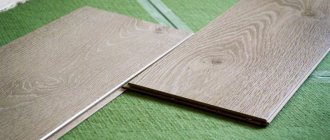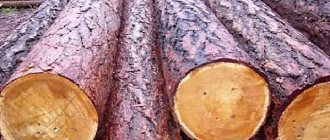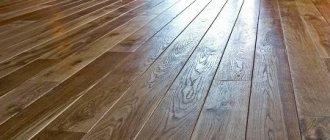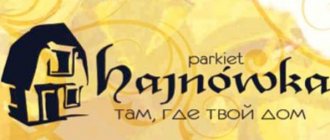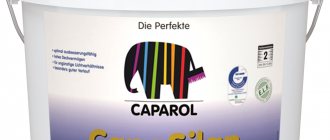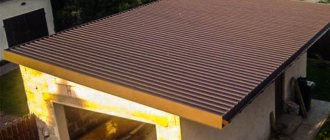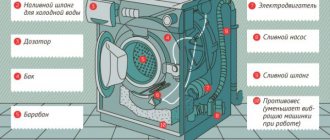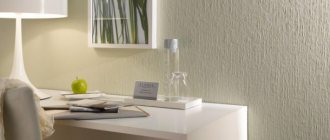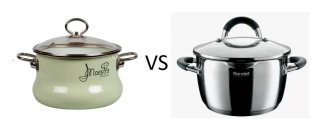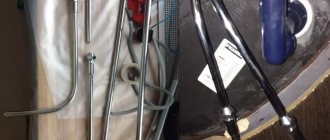The technological revolution is changing well-known building materials beyond recognition. Thus, with the advent of interlocking parquet boards, expensive and respectable parquet moves into the category of floor coverings available to the mass buyer. This type of floor is distinguished by its reliability, durability and unique beauty. Natural boards are pleasant to tactile contact, do not accumulate static charges, and can be sanded several times to restore their original appearance. All this becomes possible by following installation technology, which involves laying an intermediate layer between the subfloor and the floor covering.
The underlay for parquet is provided not only by Russian building codes (SNiP 3.04.01-87) and rules (SP 71.13330.2011), but also by European standards (CEN), adopted in 2013.
Why do you need a substrate?
The backing for a parquet board is a thin layer of non-woven material in the form of rolls or sheets. Suitable for:
- eliminating unevenness in the subfloor;
- compensation of oscillatory movements when walking;
- improving sound insulation;
- protection of floor coverings from condensation moisture;
- increasing the level of thermal protection.
Of the above functions, only the first two are considered basic. Noise, heat and waterproofing are auxiliary.
Leveling base defects. Modern materials and technologies do not allow obtaining a perfectly even screed. Even a self-leveling floor will always have slightly sagging areas or small bumps. Sanding the surface partially solves the problem, but still leaves behind the smallest irregularities, which after several months of use of the floor lead to the appearance of “play”: sagging of the boards under the weight of a walking person. In this case, an amplitude of 2-3 mm is enough for a creaking to appear first, and then the process of destruction of the locks begins.
The underlay eliminates the problem of uneven concrete bases. Correctly selected material in terms of thickness and physical properties allows you to obtain an almost ideal surface for laying parquet boards.
Compensation of amplitude fluctuations. While walking, parquet boards bend under the weight of a walking person. The lock takes on all the load. If measures are not taken to dampen oscillatory movements, the locking joints will quickly begin to collapse. Therefore, the main functions of the substrate include its ability to act as a damper (from the German word dämpfen - to dampen) layer between the floor covering and the subfloor.
Noise insulation. Concrete in a screed conducts various noises well. The thickness of the parquet board is not enough to dampen sound waves. As a result, neighbors below hear noises inside the apartment, especially footsteps on thin heels, and the owners of the apartment are well aware of what is happening below.
The substrate solves the problem. The nuances of soundproofing a parquet floor are the same as for laminate flooring. Therefore, for a more complete immersion in the problem of protecting an apartment from excess noise, we recommend that you look at the work “Soundproofing a floor under a laminate.”
Waterproofing. Everyone knows the catastrophic consequences of laminate flooring coming into contact with moisture. Parquet boards are also afraid of water, although much less so. The main threat to it is condensation moisture from the concrete base. The underlay prevents direct contact of the parquet base with moisture from below. For curious visitors, advice is to look at the article “Waterproofing under laminate.”
Thermal insulation. The substrate, regardless of what material underlies it, has good insulating properties. Its installation makes it possible to retain heat in the apartment (house), not allowing it to escape through the concrete.
However, here you need to remember that the installation of heated floors under parquet requires other properties from the substrate: reflect heat waves into the apartment or transmit them well in one direction. This can be a material with special perforation (they allow heat to pass through) or a laminated backing (the foil reflects heat upward).
Popular questions
Can the underlay be laid on any substrate?
No, the subfloor must be level, only minor imperfections are allowed. Another important issue is checking the surface for moisture. Laying the underlay and floor covering on an insufficiently dried screed or other wet base is strictly prohibited.
How to check the substrate for moisture?
The verification method is quite simple. You need to lay out a film on any area of the screed, the minimum dimensions of which are 100 x 100 cm. Having secured the edges with tape, you need to leave the beacon film for a day. If bubbles appear on the film, then the humidity exceeds the permissible threshold of 2-3.5%. It is necessary to allow time for the base to dry.
How to check the levelness of the subfloor?
Checking the evenness of the surface is carried out in two ways:
• a rule strip (2 meters or more) – the tool goes through the entire surface of the area, taking data on the gaps; an indicator of more than 3 mm per 2-3 m is considered the maximum permissible;
Pebble tiles (mosaic pebbles): scope, advantages and disadvantages, installation
• rule with wooden blocks along the edges - control is carried out similarly to the first method, taking measurements of gaps at three points of the rule along its length; differences in one direction and the other of more than 2-3 mm require alignment.
What tools are needed to lay the underlayment?
The substrate is not fixed to the base with hardware and other fixing elements. Therefore, when working with it, you only need: a stationery knife, a ruler, and tape.
Are the properties of the produced types of substrate the same?
No, technical specifications differ depending on the raw materials from which the product was made. Among the wide range there are coatings that have environmental friendliness, antibacterial effect, soundproofing qualities, etc. Each option has its own advantages and disadvantages. You should definitely familiarize yourself with them when choosing a substrate so that the purchase best suits the operational requirements and conditions.
Are there rules for placing the substrate?
When laying mats or backing sheets, the principle of brickwork or checkerboard pattern is observed. The main thing is not to continue the line of joining of fragments in two consecutive rows.
Types of substrates for parquet (parquet boards)
The underlay for parquet boards can be classified according to several criteria:
- according to the form of manufactured products;
- by the origin of the materials from which it is made;
- according to the raw materials used.
By release form
Substrate manufacturers offer two options for their products:
- roll - produced mainly from artificial materials;
- sheet made of cork, pine needles and polystyrene foam.
By origin of raw materials
Plates and rolls are made from natural (pine needles, cork) and artificial (polyethylene, polystyrene, propylene, bitumen) materials. In some cases, on the shelves of retail outlets you can see a combined version (bitumen-cork). Each of them has its own pros and cons, which will be discussed below.
By type of raw material
Based on the type of material from which the substrate is made, there are:
- polyethylene foam;
- expanded polystyrene;
- foamed propylene;
- cork;
- bitumen-cork;
- conifers;
- combined (composite).
Polyethylene. Polyethylene substrates can be of several types:
- from foamed non-cross-linked polyethylene (NPE), sold under the following brands: “Izolon”, “Isopak”, “Isoprol”, “Penolin”, “Porilex”, etc.;
Backing made of non-crosslinked polyethylene foam (NPE).
- made of cross-linked polyethylene foam (PPE) - produced under the brands Penolon, Polifom, Tatfoum;
Penolon Premium.
- foil made of cross-linked polyethylene foam - these are “Ekofol”, “Penofol”, etc.
Foil backing.
For information: you can read more about the foil backing in the material “Foil Backing”.
These are the cheapest types of damping materials, and therefore occupy a dominant position in the construction market. Such linings have their advantages:
- a fairly high level of hydro- and thermal insulation;
- ease of use - easy to cut with simple installation;
- inertness to most chemicals;
- does not serve as a basis for the proliferation of fungus and mold;
- does not fit into the rodent food chain.
At the same time, this type of substrate has several significant disadvantages:
- low strength, which manifests itself in the loss of shock-absorbing properties within 3-5 years (compressed);
- afraid of ultraviolet radiation - rapidly deteriorates when exposed to sunlight;
- low soundproofing properties.
Expanded polystyrene. Expanded polystyrene substrates are available in the form of:
- mats (sheets) - brands “Isoshum”, “Aberhof”;
- accordions - “Solid”;
- rolls - “Isopolin” (Poland).
The material has many strengths:
- durable - the service life coincides with the service life of the parquet board;
- retains elasticity until the end of its service life;
- can be laid without waterproofing, which is a big advantage over other types of substrates;
- restores its original shape after prolonged static load;
- serves as a good insulator due to its porous structure;
- absorbs sounds well - the noise absorption level reaches 70%;
- retains elasticity at temperatures from - 50oC to + 75oC (can be installed in the country without any problems);
- has precise geometric dimensions, which facilitates the flooring process;
- Light weight and compactness allow the material to be transported in passenger cars.
Among the disadvantages it should be noted:
- low ability to level out screed protrusions - a thickness of 3 mm eliminates an error in the base of the floor of only 1 mm;
- immediately after laying the floor covering it temporarily sags - the problem disappears after 4-5 weeks;
- Sold only in rolls and packs, resulting in surplus quite often;
- breaks under strong bending;
- cannot be laid on a wooden floor or plywood - the wood under the polystyrene actively rots;
- flammable - contains 92% carbon and 8% hydrogen.
You can read more about the polystyrene foam substrate in the material “Substrate for polystyrene foam laminate.”
Foampropylene. Propylene foam backing (Isopak) is not popular among the Russian population, despite its low price. There are several reasons:
- short service life - no more than 10 years, after which it turns into dust;
- highly flammable;
- releases very toxic substances;
- poor sound insulation.
The only advantages include good moisture resistance and an affordable price.
Cork. A cork underlay performs its functions best under parquet flooring - it almost perfectly levels out errors in the surface of the subfloor. She has:
- high heat and sound insulation properties;
- practical sizes;
- long service life.
The only negative is the very high price. Represented by well-known brands in the world: “Vintage”, “Amorim Group”, “Egen”, “Wicanders”, “Sedacor” and “Steico”. Available in rolls and sheets.
For information: detailed information about the cork substrate can be obtained on our website in the work “Cork substrate for laminate”.
Bitumen-cork. The bitumen-cork substrate consists of bitumen-impregnated kraft paper and a layer of cork chips. It has the same performance characteristics as pure cork material. However, this type of damper has one significant advantage: increased moisture resistance.
Coniferous. The coniferous underlay was conceived as an alternative to other types of underlays for a wooden subfloor, since under polystyrene foam and propylene the wood is prone to rapid rotting, and under polystyrene it rots.
In Russia it is also laid on top of a concrete screed. However, in this case, fundamental contradictions arise. So, on a concrete surface there is high humidity due to condensation, and pine needles instantly become moldy in humid conditions. This requires waterproofing in the form of a film, and the manufacturers of the substrate do not recommend laying it on polyethylene.
The substrate has quite a lot of advantages that customers like:
- durability - service life is about 20 years (possibly more, but there are no accumulated statistics);
- low coefficient of thermal conductivity - serves as an excellent insulation material;
- high density, due to which sharp protrusions (small pebbles) on the surface of the screed are well leveled;
- elasticity, allowing to maintain a weight of about 20 tons per 1 m2 without deformation of the underlying layer;
- high level of sound absorption (19-22 dB);
- fire resistance - at high temperatures the substrate does not support the combustion process - it becomes charred;
- environmentally friendly - natural materials are used in production.
Among the disadvantages:
- high price;
- accumulates water, after which it becomes a favorable basis for the development of mold and mildew;
- It smells bad in the first few weeks after flooring.
Available only in mat form. The most famous manufacturers: Polish, “Isoplaat” (Estonia), “LATTIALEIJONA” (“Lattilona” Finland) and “Cezar” (Poland). The characteristics of the coniferous substrate are discussed in more detail in the work “Coniferous Substrate and Its Features.”
Combined (composite). The combined substrate is represented by the “Tuplex” trademark. It has a top and bottom made of polyethylene film, the middle is made of polystyrene foam, made in the form of balls. Moreover, each layer has its own functions: the bottom allows moisture to pass upward, the middle serves as a damper layer, and the top retains water molecules in both directions. This structure of the material makes it possible not to perform waterproofing work.
At Tuplex:
- long service life;
- good flexibility;
- the ability to perfectly level out differences in height at the base of the floor.
However, there are also significant disadvantages:
- high price;
- The middle layer contains styrene, which is harmful to health, which requires daily ventilation of the room for 1-2 months after laying the Tuplex underlay under the parquet board.
What is it needed for?
The underlayment is laid when parquet blocks are laid as a floating floor or nailed to the joists. If you plan to glue the parquet, then you won’t need to lay anything down. There should not be anything extra between the base, glue and wooden finish.
Underlayment layer under the parquet board:
- Dampenes impact sounds and reduces the level of household noise in the room.
- Prevents steam from rising from the interfloor to the parquet wood.
- Provides a tight fit of the tree to the base.
On the one hand, the substrate prevents the parquet blocks from getting wet from rising steam. On the other hand, it eliminates drafts under the parquet, which reduces the risk of it drying out and cracking. If the bedding is neglected, then sooner or later the finish in question will begin to creak and deform, and will also crack along the seams between the boards.
Floor construction with underlay
Criterias of choice
A huge selection of substrates from domestic and foreign manufacturers with different prices and different properties makes it very difficult to select a specific material for parquet. Which underlay for parquet boards is better, what to choose? Based on expert advice, we will highlight the main and secondary selection criteria.
Main characteristics of the material:
- price;
- durability;
- ability to resist fungus and mold.
The secondary ones include:
- thickness;
- level of heat and sound insulation (judging by reviews on forums, many city residents place sound insulation in second place, after the cost of the material);
- release form.
Which is cheaper?
In the lower price sector there are substrates based on polyethylene and propylene, in the middle - polystyrene foam, in the upper - pine needles, cork, cork with bitumen and "Tuplex".
You need to immediately cross off all budget materials from the list. The reason is that the low price corresponds to a short service life - no more than 15 years. If such a material can be used with a laminate - the service life of both materials is almost the same, then it cannot be laid under parquet - its durability is 2-3 times higher. There is one more point here: if there is money for parquet, then there will be money for the corresponding substrate.
Attention: the author adopted the concept of not further considering those types of materials that were rejected at any stage of comparison.
Durability
Given the long service life of parquet boards, it is necessary to look for a material with a service life of 30 years or more. All materials remaining on the list meet these requirements.
Property to resist mold and mildew
According to this criterion, only pine needles are a problematic material. It cannot be used in the bathroom, kitchen and in apartments on the first floor with a damp basement.
Thickness
For some reason, there is a widespread belief that the thicker the substrate, the better. Construction forums are generally full of reviews about laying the substrate in two layers, as a result of which excellent sound insulation of the apartment and a good level of thermal protection are achieved. All this is true. There's no point in arguing.
But the owners miss an important point - the oscillatory movements of the board while walking. With a substrate 2-3 mm thick, the amplitude does not exceed 2 mm, which corresponds to GOST and does not affect the strength of the locks. An increase in the thickness of the substrate for each millimeter leads to an increase in the span by an additional 2 mm. As a result, on a substrate 4-6 mm thick, the parquet board will fluctuate up and down by 4-5 mm, which is a death sentence for the locking joint.
Conclusion: the best underlay for a parquet board should have a thickness of no more than 3 mm (ideal - 2 mm).
Level of heat and sound insulation
Cork and pine needles have the highest rates of heat and sound insulation. If these characteristics come first, then the choice is obvious: cork or bitumen-cork substrate. It is still better to use a coniferous substrate on a wood base: board, plywood.
Release form
Experts prefer to work with the material in the form of sheets (mats), which is very important when walking directly on the substrate is prohibited.
Thickness of the plank for “warm floors”
Parquet boards with a thickness of over 10 mm can withstand temperature increases up to +27C. The varnish layer and the strength of the sandwich will not change. However, heating must be done slowly to avoid damaging the wood. Only a water system can meet these requirements. The thickness of the pipe screed for uniform heating is at least 5 cm. During installation, waterproofing must be laid. There is only one installation option - gluing to the screed.
For “warm floors”, parquet boards with a plank thickness are not used:
- up to 10 mm – they cannot withstand mechanical loads, cracks appear due to temperature changes, and the already short service life of the floor is reduced;
- from 20 mm - due to low thermal conductivity, significantly more electricity has to be spent on heating.
The recommended covering option for heated floors are planks - 13-15 mm.
Which substrate is better to choose and in what cases
As noted above, for a wooden subfloor there are no other options other than pine needles. In other cases, the editors advise:
- for the first floor it is better to choose “Parkolag” with a thickness of 3 mm with increased heat-insulating properties;
- For a children's room with constant running, screaming and squealing, it is better to purchase “Steico Underfloor” or “ReFoam 3002”. Their properties make it possible to effectively dampen various types of noise;
- for private houses on the ground floor it is best to use Eco-cover 1000x500x3;
- if you suddenly don’t have enough money for a branded backing, Tarkett 2 mm thick will help.
General recommendation: in terms of price/quality ratio, the best substrates are the brands “Isoshum”, “Aberhof”, “Solid”. If the price factor is not taken into account, then it is advisable to choose a substrate made of cork or bitumen-cork material.
Rules for laying the substrate
Laying the underlay is easy. The main thing is to follow a few simple rules.
- The surface of the screed or subfloor must be clean.
- When waterproofing the base with polyethylene film, the latter is overlapped and placed on the walls. The joints are glued together with tape.
- The elastic backing is placed on the walls, the cork and pine needles are laid close to each other, but at a distance of 1 cm from the wall (technological gap).
- All seams are taped.
- You cannot walk on the substrate, except for pine needles.
